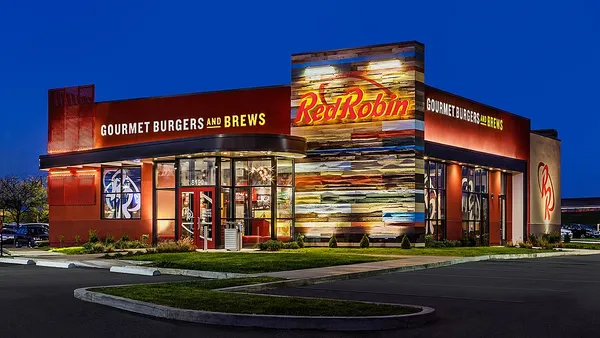Dive Brief:
- Walk-On’s Sports Bistreaux plans to open multiple corporate-owned restaurants in the Atlanta-area in 2025 that feature a new format, the company said in an email. This will be the first time the brand has opened new corporate restaurants since 2016.
- The new prototype includes a refreshed exterior and interior design, in addition to technological upgrades to its kitchen equipment.
- The company has been undergoing various strategic shifts this year and recently hired its second CEO in two years, Chris Porcelli, who was previously CFO at the chain.
Dive Insight:
Walk-On’s smaller restaurants are expected to improve the guest experience, Porcelli said in a statement. Additionally, its kitchen technology is designed to streamline operations, improve order accuracy and efficiency, Porcelli said in an email. He did not say what pieces of its kitchen equipment were changing.
“These tools make our operations more agile and allow our team to focus even more on delivering an exceptional experience to every guest,” Porcelli said. “The efficient kitchen flow and new technology mean faster service times and greater consistency in our scratch-made dishes.”
The new design can fit in footprints that are 50% smaller than current restaurants, he said. The new prototype will be 5,500 to 6,700 square feet compared to its typical 8,000- to 10,000-square-foot restaurants, according to Nation’s Restaurant News.
Per the renderings, Walk-On’s new dining room will center around a square bar with several television screens. Dining tables circle the bar, allowing diners to view some screens wherever they sit. The exterior will include a patio and an area for guests to play lawn games like corn hole and giant Jenga. Additionally, the dining room has comfortable seating and improved acoustics, the company said.
“We’ve taken a lot of time to meet with our franchisees and ask them about the opportunities they face and collaborate to identify ways in which we can simplify operations,” Jennifer Striepling, Walk-On’s chief development officer, said in a statement. “A reduced footprint provides the tools to increase efficiency and ROI for our current franchisees to expand their businesses successfully and for new franchisees to join the roster.”
Estimated initial investment for franchisees ranges from $1.6 million to over $7 million, according to the chain's 2024 franchise disclosure document, so any reduction in store size could help franchisees save costs.
The chain has aggressive growth goals and its private equity partner, 10 Point Capital, previously said it envisions Walk-On’s as a 500-plus unit brand. But it has a long way to go. At the end of 2024, the chain had about 80 units, of which six were company owned, according to its FDD.
Other chains have been working on redesigns this year. Perkins is working on new signage and a redesign of its interiors and exteriors to provide a more modern look, as well as a smaller fast casual concept Griddle & Go, which will help it develop in new markets and store formats, like travel centers. Potbelly, Wingstop, Jack in the Box and Chick-fil-A have all been trialing smaller units or off-premise-only units over the past few years.














